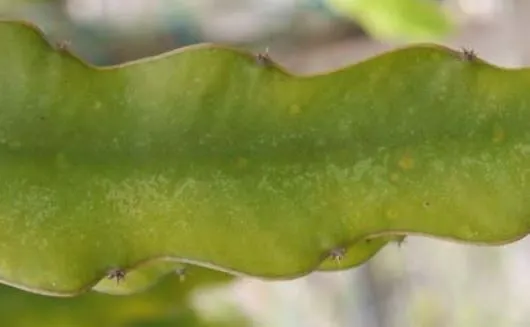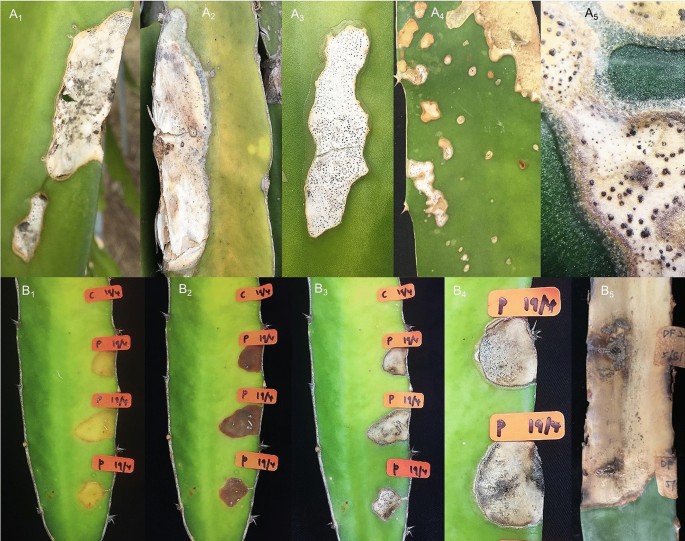In the realm of agricultural challenges, powdery mildew in dragon fruit stands as a formidable adversary, threatening the health and productivity of these exotic succulents. This article delves deep into the intricate world of plant pathology to unveil the nuances of powdery mildew infestations in dragon fruit, offering insights into detection, prevention, and management strategies.
Table of Contents

What is powdery mildew?
Various species of the Erysiphales order are responsible for the fungal disease powdery mildew. This stealthy pathogen thrives in temperate climates, where moderate temperatures and high humidity create ideal conditions for its proliferation. A significant threat to a variety of plant species, including dragon fruit (Hylocereus spp.), powdery mildew is characterized by a powdery white growth on the surface of leaves, stems, and fruits.
The Lifecycle of Powdery Mildew
Understanding the lifecycle of powdery mildew is crucial for devising effective management strategies. Unlike many fungal pathogens, powdery mildew does not require water for infection. Instead, it spreads via airborne spores, which can travel significant distances under favorable environmental conditions.
The lifecycle of powdery mildew begins with the germination of spores on susceptible plant surfaces. These spores give rise to hyphae, which penetrate the plant’s epidermal cells, establishing a foothold for colonization. As the fungus proliferates, it forms characteristic white patches of mycelium, eventually producing reproductive structures known as conidia. These conidia serve as vehicles for further dissemination, perpetuating the cycle of infection.

The Intricacies of Powdery Mildew in Dragon Fruit
Dragon fruit (Hylocereus spp.) is renowned for its ornamental beauty and delectable taste, but its susceptibility to powdery mildew poses a significant challenge to growers worldwide. The unique anatomical and physiological characteristics of dragon fruit plants contribute to their vulnerability to fungal infestations.
Environmental Triggers and Predisposing Factors
Several environmental factors can predispose dragon fruit plants to powdery mildew infestations. High humidity levels, inadequate air circulation, and fluctuations in temperature create favorable conditions for fungal growth and propagation. Additionally, plant stressors such as nutrient deficiencies, water stress, and overcrowding exacerbate susceptibility to powdery mildew infections.
Symptoms of Powdery Mildew in Dragon Fruit
Recognizing the early symptoms of powdery mildew infestations is paramount for timely intervention. The characteristic white, powdery growth on the surface of leaves, stems, and fruits serves as a visual hallmark of powdery mildew infections in dragon fruit. As the disease progresses, affected tissues may exhibit necrosis, wilting, and premature leaf drop, compromising the plant’s health and vigor.
Strategies for Powdery Mildew Management
The management of powdery mildew in dragon fruit requires a multifaceted approach, integrating cultural, chemical, and biological control strategies. By implementing proactive measures and leveraging innovative solutions, growers can mitigate the impact of powdery mildew infestations and safeguard the health of their crops.
Cultural Practices
Cultural practices play a pivotal role in powdery mildew management, focusing on environmental manipulation and plant health optimization. Enhancing air circulation through proper spacing and pruning reduces humidity levels and minimizes fungal spore dissemination. Moreover, maintaining optimal soil moisture levels and providing adequate nutrition bolster the plant’s natural defenses against powdery mildew infections.
Chemical Control
Chemical control options offer an effective means of suppressing powdery mildew outbreaks in dragon fruit cultivation. Fungicidal formulations containing active ingredients such as sulfur, potassium bicarbonate, and neem oil demonstrate efficacy in inhibiting fungal growth and preventing spore germination. However, it is imperative to adhere to recommended application rates and safety guidelines to minimize environmental impact and mitigate the risk of resistance development.
Biological Control Agents
Biological control agents present a sustainable alternative for powdery mildew management, harnessing the power of beneficial microorganisms to combat fungal pathogens. Biopesticides containing antagonistic fungi, such as Trichoderma spp., and bacterial species like Bacillus subtilis, offer targeted suppression of powdery mildew populations while preserving ecological balance. Integrating biological control agents into integrated pest management (IPM) programs promotes long-term disease control and reduces reliance on synthetic chemicals.

Conclusion: Navigating the Landscape of Powdery Mildew in Dragon Fruit
In the intricate tapestry of agricultural ecosystems, the specter of powdery mildew looms large, posing a formidable challenge to dragon fruit growers worldwide. By unraveling the intricacies of powdery mildew biology and implementing comprehensive management strategies, growers can fortify their crops against fungal infestations and sustainably optimize yield and quality.
As the agricultural community continues to innovate and collaborate, the quest for resilient dragon fruit varieties and sustainable disease management practices holds promise for a vibrant and thriving industry. Together, we can navigate the landscape of powdery mildew in dragon fruit and cultivate a future of resilience, productivity, and abundance.
